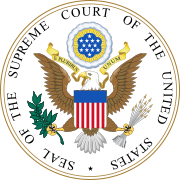|
List of United States Supreme Court cases, volume 78
This is a list of cases reported in volume 78 (11 Wall.) of United States Reports, decided by the Supreme Court of the United States in 1871, along with cases from 1867 and 1869.[1] Nominative reportsIn 1874, the U.S. government created the United States Reports, and retroactively numbered older privately-published case reports as part of the new series. As a result, cases appearing in volumes 1–90 of U.S. Reports have dual citation forms; one for the volume number of U.S. Reports, and one for the volume number of the reports named for the relevant reporter of decisions (these are called "nominative reports"). John William WallaceStarting with the 66th volume of U.S. Reports, the Reporter of Decisions of the Supreme Court of the United States was John William Wallace. Wallace was Reporter of Decisions from 1863 to 1874, covering volumes 68 through 90 of United States Reports which correspond to volumes 1 through 23 of his Wallace's Reports. As such, the dual form of citation to, for example, Ludlow v. Ramsey is 78 U.S. (11 Wall.) 581 (1871). Wallace's Reports were the final nominative reports for the US Supreme Court; starting with volume 91, cases were identified simply as "(volume #) U.S. (page #) (year)". Justices of the Supreme Court at the time of 78 U.S. (11 Wall.)The Supreme Court is established by Article III, Section 1 of the Constitution of the United States, which says: "The judicial Power of the United States, shall be vested in one supreme Court . . .". The size of the Court is not specified; the Constitution leaves it to Congress to set the number of justices. Under the Judiciary Act of 1789 Congress originally fixed the number of justices at six (one chief justice and five associate justices).[2] Since 1789 Congress has varied the size of the Court from six to seven, nine, ten, and back to nine justices (always including one chief justice). To prevent President Andrew Johnson from appointing any justices, a hostile Congress passed the Judicial Circuits Act of 1866, eliminating three of the 10 seats from the Supreme Court as they became vacant, and so potentially reducing the size of the court to seven justices. The vacancy caused by the death of Justice John Catron in 1865 had not been filled, so after Justice James Moore Wayne died in July 1867 there were eight justices left on the court at the start of the term when the cases in 78 U.S. (11 Wall.) were decided; however Justice Robert Cooper Grier resigned at the end of January 1870, temporarily reducing the Court to seven justices. Newly confirmed justices William Strong and Joseph P. Bradley joined the Court in March 1870, in the final weeks of the session. This brought the Court back to nine justices, the number set by the Judiciary Act of 1869. Fluctuations in Supreme Court membership, 1864-1870
Notable Case in 78 U.S. (11 Wall.) Virginia v. West VirginiaIn Virginia v. West Virginia, 78 U.S. (11 Wall.) 39 (1871), the Supreme Court held that when a governor has discretion in the conduct of an election, the legislature is bound by his actions and cannot undo the results based on fraud. The Court implicitly affirmed that the breakaway Virginia counties had received the necessary consent of both Virginia and the United States Congress to become a separate U.S. state, and explicitly held that the counties of Berkeley and Jefferson were part of the new State of West Virginia. Although the Court never directly ruled on the constitutionality of West Virginia's creation, decisions such as those in Virginia v. West Virginia led to a de facto recognition of the state which is now unassailable.[3] Citation styleUnder the Judiciary Act of 1789 the federal court structure at the time comprised District Courts, which had general trial jurisdiction; Circuit Courts, which had mixed trial and appellate (from the US District Courts) jurisdiction; and the United States Supreme Court, which had appellate jurisdiction over the federal District and Circuit courts—and for certain issues over state courts. The Supreme Court also had limited original jurisdiction (i.e., in which cases could be filed directly with the Supreme Court without first having been heard by a lower federal or state court). There were one or more federal District Courts and/or Circuit Courts in each state, territory, or other geographical region. Bluebook citation style is used for case names, citations, and jurisdictions.
List of cases in 78 U.S. (11 Wall.)Notes and references
See alsoExternal links
|
|||||||||||||||||||||||||||||||||||||||||||||||||||||||||||||||||||||||||||||||||||||||||||||||||||||||||||||||||||||||||||||||||||||||













